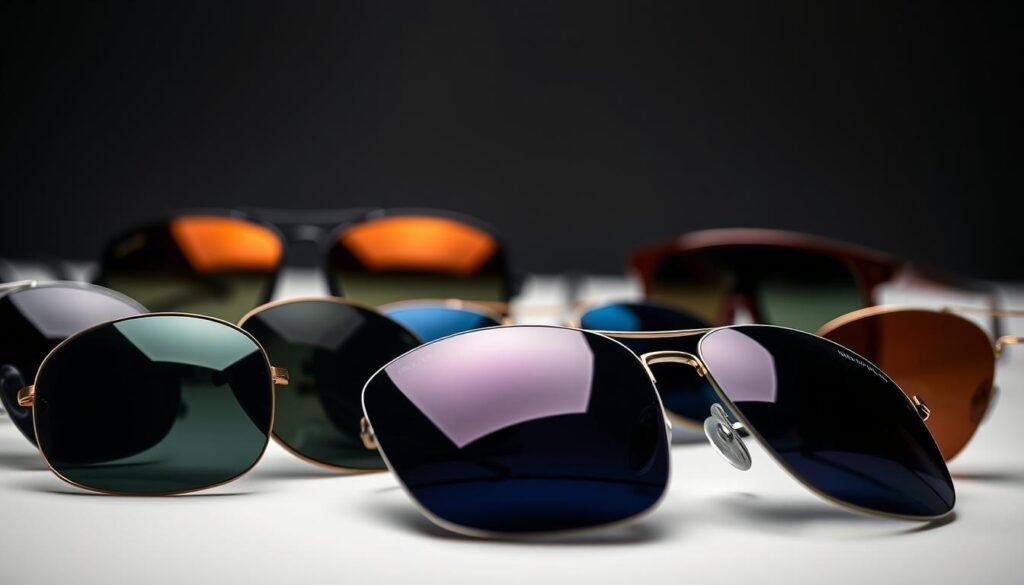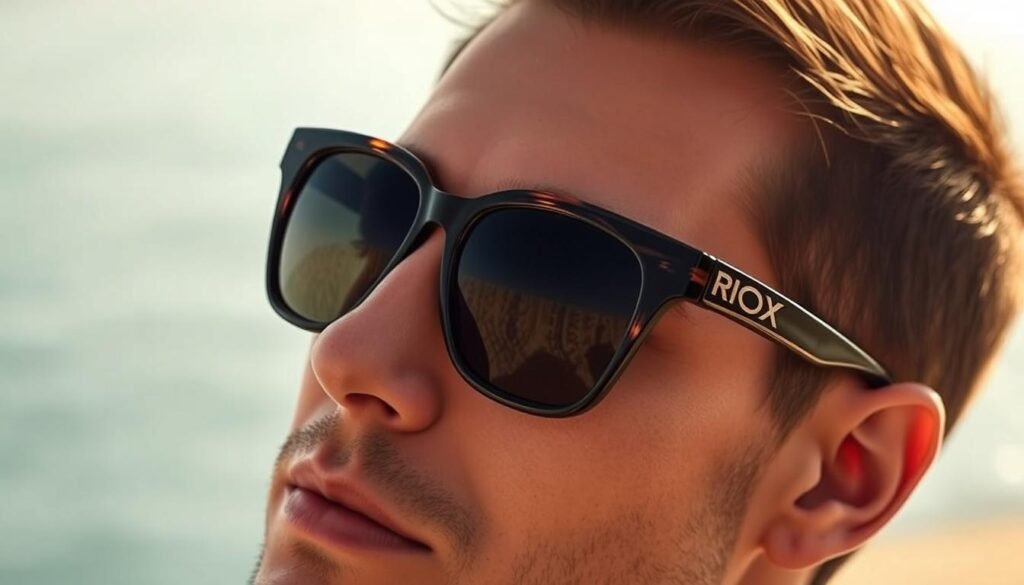Welcome to your go-to resource for choosing eyewear that truly safeguards your vision while keeping you comfortable outdoors. Whether you’re hiking, driving, or relaxing at the park, the right pair does more than elevate your style—it acts as a shield against invisible threats.
Ultraviolet (UV) radiation poses serious risks to eye health, with both UVA and UVB rays contributing to long-term damage. High-quality options block 99-100% of these harmful rays, reducing glare and preventing squinting that leads to headaches. This protection isn’t just for summer—snow, water, and even cloudy days reflect UV light year-round.
Children need extra attention, as their eyes absorb more UV than adults’ during playtime and sports. Look for durable frames and impact-resistant lenses designed for active lifestyles. Pair these features with wraparound designs for maximum coverage during all-day adventures.
Key Takeaways
- UV-blocking lenses prevent cumulative damage linked to cataracts and macular degeneration
- Polarized options reduce glare during water sports or driving
- Kids’ eyewear requires specialized UV filtration and impact resistance
- Protection matters in all seasons, not just bright summer days
- Combine coverage, lens quality, and comfort for optimal results
We’ll break down how to spot genuine protective features, compare lens technologies, and find options that fit your daily routine. Let’s ensure your next pair works as hard as you do!
Understanding UV Radiation and Its Impact on Eye Health
Sunlight contains invisible threats that affect more than just your skin. Ultraviolet (UV) radiation comes in three forms: UVA, UVB, and UVC. While UVC gets absorbed by Earth’s atmosphere, UVA and UVB rays reach us daily, even through cloud cover.
How UVA and UVB Rays Affect Vision
UVA rays dive deep into the eye, targeting the macula—the central vision hub for reading and recognizing details. Over time, this damages cells that can’t regenerate. UVB rays focus on the lens, causing gradual cloudiness that disrupts light filtering. Both types accelerate aging processes within ocular structures.
Risks of Cataracts, Macular Degeneration, and Eye Strain
The World Health Organization links 20% of cataract cases directly to UV exposure. Left unchecked, cumulative damage also raises risks for macular degeneration and photokeratitis—a painful corneal sunburn. Kids face higher dangers since their eyes absorb 3x more UV than adults’ during outdoor play.
Surprisingly, 80% of UV exposure occurs before age 18. Snow, water, and concrete reflect up to 90% of rays, creating unexpected glare. Daily protection becomes vital—like applying sunscreen to your vision.
Selecting the Best Sunglasses for Eyes
Not all protective eyewear offers equal defense against harmful rays. Labels hold critical clues about real safety features. Let’s decode what matters most when evaluating coverage claims.
Decoding Certification Marks
UV400 means lenses block rays up to 400 nanometers—the full spectrum of UVA and UVB light. This standard matches “100% UV protection” labels. Both guarantee complete shielding from solar damage.
Watch for alternative terms like “UV absorption up to 400nm.” These phrases confirm equal protection levels. Darker tints might feel safer but don’t boost UV filtering. Always check certification details first.
| Label Type | Protection Level | Key Detail |
|---|---|---|
| UV400 | Blocks 99-100% of UVA/UVB | Covers rays ≤400nm |
| 100% UV Protection | Full spectrum defense | Same as UV400 standard |
| UV Absorption | Varies by stated range | Requires specific nm value |
Stick with trusted brands that meet ANSI or ISO standards. Counterfeit products often use similar wording but lack proper testing. Retailers with clear return policies help ensure quality.
Remember: Style and price don’t determine safety. A $10 pair with verified UV400 labels outperforms expensive fakes. Your eyes deserve proven protection.
Exploring Lens Materials, Tints, and Coatings
Your eyewear’s performance starts with smart material choices. Let’s examine how different components affect durability, clarity, and protection levels.

Material Showdown: Strength vs Clarity
Polycarbonate leads with natural UV-blocking and shatter resistance. Ideal for sports, these lenses stay lightweight during long wear. Acrylic offers budget-friendly clarity but often needs extra coatings for full protection. Glass delivers unmatched scratch resistance and crisp vision, though its weight and fragility limit active use.
Tint Tactics: Matching Colors to Activities
Gray lenses keep colors true while cutting glare—perfect for beach days. Brown/amber options boost contrast on trails or roads, helping spot obstacles faster. Green tints sharpen details in bright light, reducing squint-induced headaches. Pro tip: Pair tint darkness with your environment—lighter for cloudy days, darker for snow reflections.
Coating Combos for Enhanced Performance
Anti-reflective treatments erase distracting glares from screens or water surfaces. Mirror finishes bounce back intense light while adding sleek style. Scratch-resistant layers keep lenses clear through daily adventures. Combine coatings for personalized comfort—hikers might prioritize glare reduction, while urban users benefit from smudge resistance.
Tips for Ensuring Optimal Eye Protection and Comfort
Finding eyewear that combines safety with all-day wearability requires attention to design details. Let’s explore how frame choices and specialized features work together to shield your vision without sacrificing style.
Proper Fit, Coverage, and Frame Design
A secure fit prevents gaps where UV rays can sneak in. Frames should rest evenly on your nose bridge without sliding—adjustable nose pads help customize the position. Pressure behind the ears often signals a too-tight fit.
Wraparound styles excel at blocking light entering from the sides, especially during high-glare conditions. Oversized frames add extra coverage for sensitive eyes, while lightweight materials like nylon reduce fatigue during long hikes or drives.
| Frame Material | Best For | Comfort Feature |
|---|---|---|
| Acetate | Fashion-forward looks | Flexible hinges |
| TR-90 | Active lifestyles | Shock resistance |
| Stainless Steel | Durability | Adjustable arms |

Activity-Specific Features: Polarization and Glare Reduction
Polarized lenses act like venetian blinds for your eyes. They block horizontal light waves bouncing off water, snow, or roads—ideal for fishing trips or beach days. Anglers report 73% less squinting when using polarized options.
These lenses aren’t perfect for every scenario, though. They can darken LCD screens on dashboards or phones, making them tricky for pilots or cyclists relying on GPS. For everyday use, consider non-polarized alternatives with UV400 protection.
Outdoor enthusiasts benefit most from matching activities to lens tech. Surfers need polarization to spot waves clearly, while runners prioritize wrap designs that block wind and debris. Having multiple pairs ensures you’re always prepared.
Conclusion
Shielding your vision requires more than a stylish accessory. The right pair combines verified UV400 defense with features matching your daily life—whether you’re biking mountain trails or reading outdoors.
Always prioritize labels confirming 100% UV protection. This non-negotiable feature prevents cumulative damage linked to cataracts and macular degeneration. Pair it with durable materials like polycarbonate for active conditions, or lightweight frames for all-day comfort.
Remember, harmful rays strike year-round—not just during summer months. Snowy landscapes and cloudy days reflect UV light that demands proper eyewear. Consult eye care professionals to address specific needs like light sensitivity or sports requirements.
Investing in quality protection today safeguards your vision for decades. Choose options balancing coverage, lens tech, and personal style. Your eyes will thank you every time you step outside!

